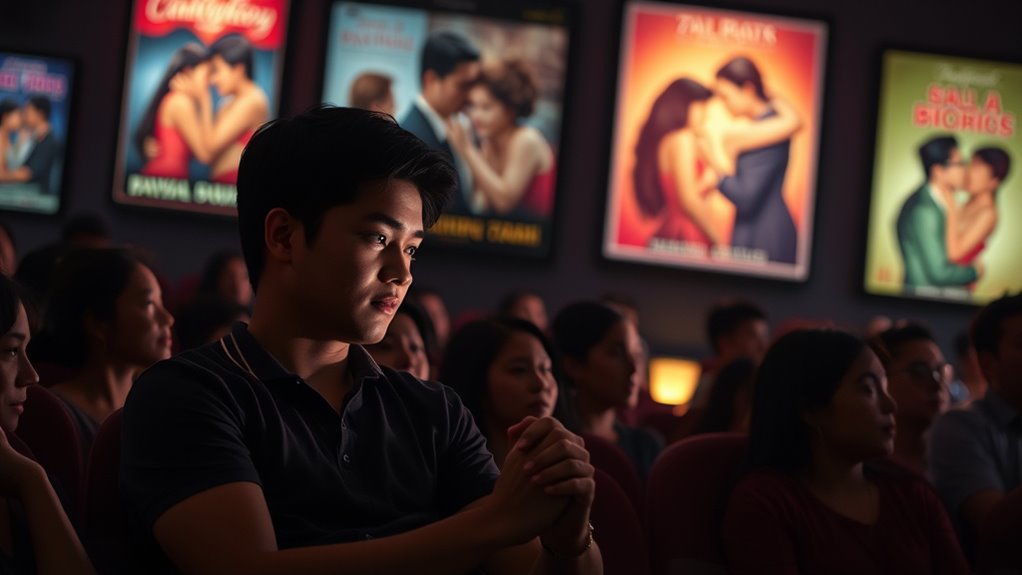Filipino movies shape your romantic ideals by showcasing traditional courtship practices and relatable love stories that resonate with your values. They highlight love teams and their enchanting dynamics, often portraying predictable plots filled with nostalgia and emotional engagement. You’ll find the emphasis on family and community ties reinforces the significance of relationships. This blend of romance and cultural identity influences how you perceive love. Discover even more fascinating insights about this enchanting cinematic world.
Key Takeaways
- Filipino movies often romanticize traditional courtship practices, reinforcing respect, family approval, and sincere relationships as ideals for love.
- The portrayal of love teams creates aspirational dynamics, influencing audience perceptions of ideal partnerships and relationships.
- Predictable plots featuring love triangles and emotional resolutions evoke nostalgia, shaping viewers’ expectations and beliefs about love’s simplicity and triumph.
- Films emphasize the importance of family involvement in romantic relationships, highlighting deep cultural roots and reinforcing collective values.
- Cinematic narratives explore the complexities of love amidst societal challenges, offering relatable stories that resonate with cultural identity and personal experiences.
The Essence of Romantic Culture in Filipino Cinema

Romantic culture pulses at the heart of Filipino cinema, where love stories dominate the screen and resonate deeply with audiences. Nearly half of the highest-grossing films are romantic comedies, showcasing everyday experiences infused with hope and love. Love teams have become a staple formula in the Filipino entertainment industry, drawing viewers in with their captivating dynamics.
You’ll often find yourself drawn into these narratives, using them as a form of escapism that promises happy endings. This genre inspires a belief in long-lasting love, with films like “Hello, Love, Goodbye” and “The Hows of Us” achieving remarkable box office success.
The on-screen chemistry between actors is enchanting, making love teams an essential part of the genre. Ultimately, these films reflect and shape cultural romantic ideals, forging a deep emotional connection that influences your understanding of love and relationships.
Traditional Courtship Practices and Their Cinematic Representation

While exploring the rich tapestry of Filipino cinema, you’ll find that traditional courtship practices play a significant role in shaping narratives and character relationships.
Customs like ligaw, harana, and paninilbihan highlight the importance of respect and family approval, often depicted in film to romanticize these values.
Ligaw, harana, and paninilbihan beautifully illustrate respect and family approval, infusing Filipino cinema with romantic nostalgia.
You’ll notice characters serenading under windows, performing household tasks, and engaging in lengthy courtships that emphasize patience and sincerity. Moreover, these films often showcase how family involvement is a cornerstone of traditional courting practices, reinforcing the value placed on familial ties in romantic relationships.
These portrayals evoke nostalgia, reinforcing ideals of love that resonate with audiences.
The films not only reflect cultural heritage but also instill a sense of admiration for these traditions, influencing how you perceive romance.
Ultimately, through cinema, these customs continue to thrive, shaping modern relationships while preserving Filipino identity.
Love Teams: The Heart of Filipino Romantic Films

Filipino cinema’s exploration of love doesn’t just stop at traditional courtship; it evolves into the phenomenon of love teams that capture the hearts of audiences.
Dating back to the 1920s with Gregorio Fernandez and Mary Walter, these partnerships have shaped the industry. Iconic pairings like Gabby Concepcion and Sharon Cuneta in the ’80s, and modern duos like John Lloyd Cruz and Bea Alonzo, dominate romantic films today.
Love teams boost actors’ careers, ensuring they collaborate on multiple projects, and often resonate deeply with fans. This connection fosters intense support, with many rooting for their favorite couples to become real-life romances.
Ultimately, love teams drive the success of rom-coms, securing their place at the heart of Filipino cinema.
Predictable Plots and Emotional Engagement

Many viewers find comfort in the predictable plots of Filipino movies, which often center around common themes like love triangles and family conflicts.
These familiar storylines evoke nostalgia and provide a sense of comfort, making it easy for you to engage emotionally. You know what to expect, allowing you to anticipate key moments that lead to satisfying emotional resolutions.
Despite their predictability, these plots resonate universally, reflecting societal norms and values. Character development and emotional intensity draw you into the story, while supporting roles add depth.
Filmmakers use music and cinematography effectively to enhance emotional engagement, making even the most predictable plots enjoyable and impactful. In this way, Filipino films create a rich tapestry of relatable experiences.
Escapism Through Idealized Love Stories

Escapism through idealized love stories captivates audiences by offering a refuge from the complexities of everyday life. You find yourself drawn into sensational tales of forbidden love, where social class differences heighten the drama.
These narratives resonate because they blend romance with relatable challenges, showcasing love as a powerful force that triumphs over adversity. You connect with characters who navigate struggles similar to your own, making their victories feel attainable.
While these films often portray an optimistic view of love, they also serve as a reminder of the harsh realities many couples face.
Ultimately, these idealized stories provide emotional respite, allowing you to escape, reflect, and perhaps reshape your expectations about love and relationships.
The Significance of Family in Romantic Narratives

Romantic narratives often blend idealized love with the complexities of family dynamics, showing how relationships are influenced by the ties that bind. Movies like *May Minamahal* illustrate how family interactions shape couples’ journeys, while *The Prenup* reveals the pressure of parental expectations on romance.
Cross-cultural challenges in films like *Basta’t Kasama Kita* highlight how family support or conflict can complicate love. The tension between individual desires and family obligations often emerges, making relationships relatable.
Additionally, the portrayal of supportive families fosters emotional stability, emphasizing the importance of acceptance and resilience. Overall, these narratives reflect the intricate balance of love and family, shaping romantic ideals in ways that resonate deeply with audiences. This is particularly relevant when considering how financial stability post-divorce can impact family dynamics and romantic relationships.
Unrequited Love and Second Chances in Film

While love can be a source of joy, it often brings heartache, especially in narratives exploring unrequited love and second chances.
Films like *I’m Drunk, I Love You* plunge into the emotional turmoil of unrequited love, showcasing characters grappling with their feelings while trying to maintain friendships. You see how these stories reflect real-life struggles, fostering empathy and understanding.
When it comes to second chances, movies like *Ngayon Kaya* emphasize the importance of timing and personal growth. Characters evolve, demonstrating that emotional resilience is key to rekindling love.
These films resonate with you because they mirror authentic experiences, reminding you how love’s complexities can lead to both heartache and new beginnings.
Idealized Love and Viewer Perceptions

Filipino films’ exploration of love often elevates romantic ideals, creating a vision that many viewers aspire to. The cultural romanticism embedded in these movies glorifies love through traditional practices, like ligaw and harana.
You might find yourself captivated by the escapist storylines that often feature unrealistic yet appealing romances, culminating in happy endings that reinforce your belief in lasting love. These narratives, while predictable, emotionally engage you, making them satisfying to watch.
As you absorb these stories, they shape your expectations for real-life relationships, promoting a romantic idealism that may not reflect reality. Ultimately, these films inspire you to seek similar experiences in your own life, leaving an indelible mark on your perceptions of love.
The Impact of Filipino Films on Cultural Identity and Values

As you immerse yourself in Filipino films, you quickly realize how these stories shape cultural identity and values. They often reflect the complexities of historical colonization, showcasing a hybrid of inherited values that influence how you perceive your own identity.
While films provide a form of escapism, they also encourage you to explore and redefine what it means to be Filipino. Through character archetypes and narratives, you connect with strong heroes and traditional courtship practices, reinforcing deep cultural roots.
Additionally, language choices in films serve as a powerful tool for cultural representation, enhancing national pride. Ultimately, these cinematic experiences contribute to your understanding of personal identity and the importance of family and community in Filipino culture.
Frequently Asked Questions
How Do Filipino Films Differ From Romantic Films in Other Cultures?
Filipino films differ from romantic films in other cultures primarily through their emphasis on family values and cultural traditions. You’ll notice themes of “ligaw” and “harana” that reflect deep-rooted cultural practices.
Unlike many Western rom-coms, Filipino movies often explore melancholic realism and sentimentalism, focusing on emotional depth.
Additionally, they frequently incorporate local settings, blending romantic fantasies with everyday challenges, creating a unique viewing experience that resonates with audiences on multiple levels.
What Role Do Music and Soundtracks Play in Filipino Romantic Films?
Imagine the sweet notes of a familiar song wrapping around you like a warm embrace. In Filipino romantic films, music and soundtracks play a crucial role, heightening emotions and making moments unforgettable.
They weave seamlessly into the narrative, revealing characters’ innermost feelings even when words fall short. As melodies resonate, they set the mood, drawing you deeper into the story, creating a shared experience that lingers long after the credits roll.
How Do Social Media Influence Viewer Perceptions of Filipino Romantic Films?
Social media greatly influences your perceptions of Filipino romantic films.
You see amplified visibility as platforms showcase these movies to a global audience, shaping your expectations and desires. Engaging with fan communities and celebrity content creates a connection that can idealize romance in your mind.
As influencers endorse specific narratives, you might find yourself drawn to those ideals, shaping how you view relationships and love based on what you consume online.
What Are Some Well-Known Filipino Romantic Films That Exemplify These Themes?
If you’re looking for well-known Filipino romantic films that exemplify themes of love and relationships, you can’t miss “Got 2 Believe,” which explores opposites attracting.
“Labs Kita, Okay Ka Lang?” dives into the friend-to-lover shift.
“Basta’t Kasama Kita” highlights love overcoming social class barriers, while “A Lotto Like Love” showcases chance encounters.
Finally, “A Girl and a Guy” reflects modern relationship dynamics.
Each film beautifully captures the essence of romance in various forms.
How Do Gender Roles Manifest in Filipino Romantic Cinema?
You might’ve noticed that Filipino romantic cinema often presents gender roles in a specific light.
Women are frequently shown as victims, enduring love’s trials, while men typically embody strength and assertiveness. This dynamic reinforces traditional stereotypes, making you question societal expectations.
The emotional intensity in these films reflects cultural values, but as you watch, consider how these portrayals shape your understanding of romance and relationships in real life.
Are they empowering or limiting?
Conclusion
To sum up, Filipino movies play a pivotal role in shaping romantic ideals, reflecting both tradition and modernity. Did you know that over 70% of Filipinos believe that film influences their views on love and relationships? This highlights the powerful connection between cinema and cultural perceptions. As you immerse yourself in these films, you not only enjoy the stories but also engage with the values and emotions that define love in the Filipino context.









